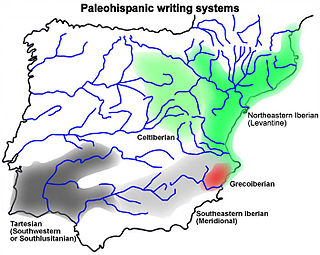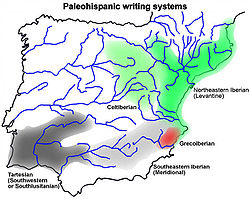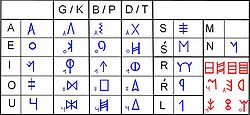
Tartessos is, as defined by archaeological discoveries, a historical civilization settled in the southern Iberian Peninsula characterized by its mixture of local Paleohispanic and Phoenician traits. It had a writing system, identified as Tartessian, that includes some 97 inscriptions in a Tartessian language.
The Phoenician alphabet is an abjad used across the Mediterranean civilization of Phoenicia for most of the 1st millennium BC. It was one of the first alphabets, and attested in Canaanite and Aramaic inscriptions found across the Mediterranean region. In the history of writing systems, the Phoenician script also marked the first to have a fixed writing direction—while previous systems were multi-directional, Phoenician was written horizontally, from right to left. It developed directly from the Proto-Sinaitic script used during the Late Bronze Age, which was derived in turn from Egyptian hieroglyphs.

The Iberians were an ancient people settled in the eastern and southern coasts of the Iberian Peninsula, at least from the 6th century BCE. They are described in Greek and Roman sources. Roman sources also use the term Hispani to refer to the Iberians.

The Iberian scripts are the Paleohispanic scripts that were used to represent the extinct Iberian language. Most of them are typologically unusual in that they are semi-syllabic rather than purely alphabetic. The oldest Iberian inscriptions date to the 4th or possibly the 5th century BCE, and the latest from end of the 1st century BCE or possibly the beginning of the 1st century CE.

The Celtiberian script is a Paleohispanic script that was the main writing system of the Celtiberian language, an extinct Continental Celtic language, which was also occasionally written using the Latin alphabet. This script is a direct adaptation of the northeastern Iberian script, the most frequently used of the Iberian scripts.

Lusitanian was an Indo-European Paleohispanic language. There has been support for either a connection with the ancient Italic languages or Celtic languages. It is known from only six sizeable inscriptions, dated from c. 1 CE, and numerous names of places (toponyms) and of gods (theonyms). The language was spoken in the territory inhabited by Lusitanian tribes, from the Douro to the Tagus rivers, territory that today falls in central Portugal and western Spain.

The Cynetes or Conii were one of the pre-Roman peoples of the Iberian Peninsula, living in today's Algarve and Lower Alentejo regions of southern Portugal, and the southern part of Badajoz and the northwestern portions of Córdoba and Ciudad Real provinces in Spain before the 6th century BC. According to Justin's epitome, the mythical Gargoris and Habis were their founding kings.

Tartessian is an extinct Paleo-Hispanic language found in the Southwestern inscriptions of the Iberian Peninsula, mainly located in the south of Portugal, and the southwest of Spain. There are 95 such inscriptions, the longest having 82 readable signs. Around one third of them were found in Early Iron Age necropolises or other Iron Age burial sites associated with rich complex burials. It is usual to date them to the 7th century BC and to consider the southwestern script to be the most ancient Paleo-Hispanic script, with characters most closely resembling specific Phoenician letter forms found in inscriptions dated to c. 825 BC. Five of the inscriptions occur on stelae that have been interpreted as Late Bronze Age carved warrior gear from the Urnfield culture.

The Byblos script, also known as the Byblos syllabary, Pseudo-hieroglyphic script, Proto-Byblian, Proto-Byblic, or Byblic, is an undeciphered writing system, known from ten inscriptions found in Byblos, a coastal city in Lebanon. The inscriptions are engraved on bronze plates and spatulas, and carved in stone. They were excavated by Maurice Dunand, from 1928 to 1932, and published in 1945 in his monograph Byblia Grammata. The inscriptions are conventionally dated to the second millennium BC, probably between the 18th and 15th centuries BC.

Prehistory in the Iberian peninsula begins with the arrival of the first Homo genus representatives from Africa, which may range from c. 1.5 million years (Ma) ago to c. 1.25 Ma ago, depending on the dating technique employed, so it is set at c. 1.3 Ma ago for convenience.

The Paleohispanic scripts are the writing systems created in the Iberian Peninsula before the Latin alphabet became the dominant script. They derive from the Phoenician alphabet, with the exception of the Greco-Iberian alphabet, which is a direct adaptation of the Greek alphabet. Some researchers believe that the Greek alphabet may also have played a role in the origin of the other Paleohispanic scripts. Most of these scripts are notable for being semi-syllabic rather than purely alphabetic.

The northeastern Iberian script, also known as Levantine Iberian or simply Iberian, was the primary means of written expression for the Iberian language. It has also been used to write Proto-Basque, as evidenced by the Hand of Irulegi. The Iberian language is also represented by the southeastern Iberian script and the Greco-Iberian alphabet. In understanding the relationship between the northeastern and southeastern Iberian scripts, some note that they are two distinct scripts with different values assigned to the same signs. However, they share a common origin, and the most widely accepted hypothesis is that the northeastern Iberian script was derived from the southeastern Iberian script. Some researchers have concluded that it is linked solely to the Phoenician alphabet, while others believe that the Greek alphabet also played a role.

The southeastern Iberian script, also known as Meridional Iberian, was one of the means of written expression for the Iberian language, which was primarily written in the northeastern Iberian script and, to a lesser extent, by the Greco-Iberian alphabet. In understanding the relationship between the northeastern and southeastern Iberian scripts, some note that they are two distinct scripts with different values assigned to the same signs. However, they share a common origin, and the most widely accepted hypothesis is that the northeastern Iberian script was derived from the southeastern Iberian script.

The Greco-Iberian alphabet is a direct adaptation of an Ionic variant of a Greek alphabet to the specifics of the Iberian language, thus this script is an alphabet and lacks the distinctive characteristic of the paleohispanic scripts that present signs with syllabic value, for the occlusives and signs with monophonemic value for the rest of consonants and vowels.

The Espanca script is the first signary known of the Paleohispanic scripts. It is inscribed on a piece of slate, 48×28×2 cm. This alphabet consists of 27 letters written double. The 27 letters in the outer line are written in a better hand than those of the inner line, from which it has been inferred that the slate was a teaching exercise in which a master wrote the alphabet and a student copied it.

The paleo-Hispanic languages are the languages of the Pre-Roman peoples of the Iberian Peninsula, excluding languages of foreign colonies, such as Greek in Emporion and Phoenician in Qart Hadast. After the Roman conquest of Hispania the Paleohispanic languages, with the exception of Proto-Basque, were replaced by Latin, the ancestor of the modern Iberian Romance languages.

A semi-syllabary is a writing system that behaves partly as an alphabet and partly as a syllabary. The main group of semi-syllabic writing are the Paleohispanic scripts of ancient Spain, a group of semi-syllabaries that transform redundant plosive consonants of the Phoenician alphabet into syllabograms.
This section of the timeline of Iberian history concerns events from before the Carthaginian conquests.
















